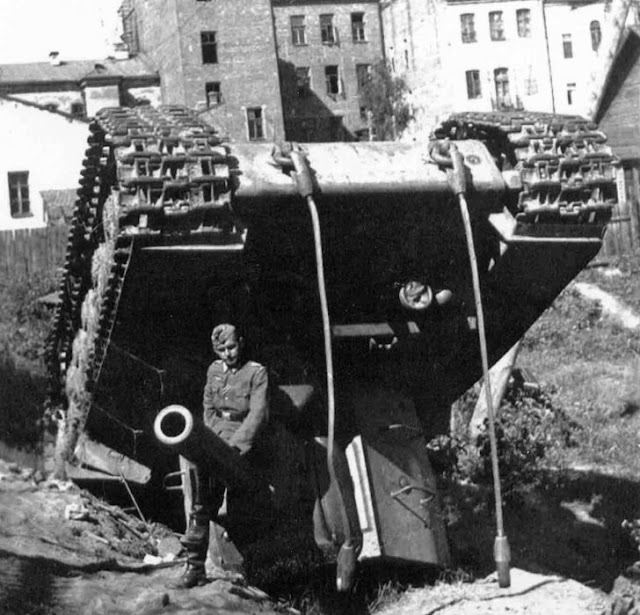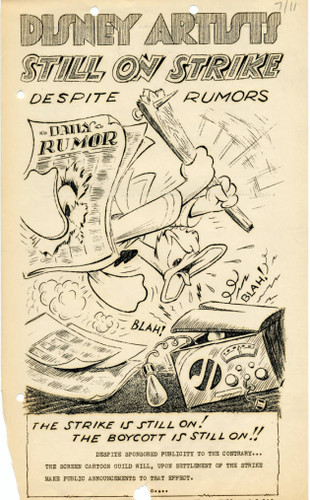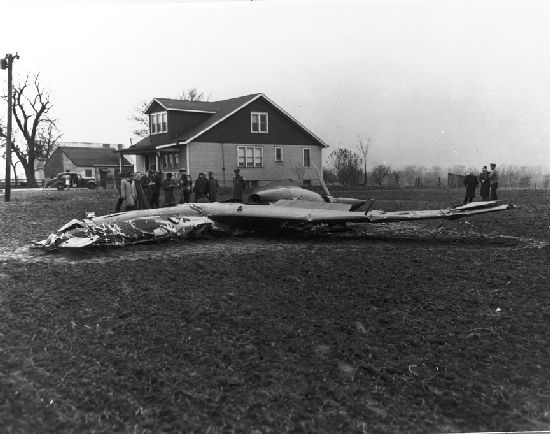Friday 11 July 1941
 |
| A Messerschmitt Bf 108 Taifun that crashed within the Reich province of Bohemia and Moravia (Czechoslovakia) on 11 July 1941. |
Eastern Front: On
11 July 1941, the Soviets mount counterattacks against the advancing panzer spearheads of the Wehrmacht. The attack fails, as have all the others, and it is easy to forget about these bloody battles. However, there is a cumulative effect on the Germans that may not be apparent now - but will tell in the end.
Despite the spectacular successes of the past few weeks, Hitler, who has too much free time on his hands at Rastenburg, is worried. Field Marshal Keitel telephones General Halder, operations boss at OKH, at noon and lists Hitler's concerns:
- Some following units are closing up too slowly on the most advanced units;
- The south flank of Army Group North and north flank of Army Group Center are not cooperating together properly, as Hitler thinks that von Bock's troops to the south are not sufficiently helping von Leeb's troops to the north;
- General Hoepner's 4th Panzer Group is "losing contact" with following infantry because it is moving too quickly.
Halder does not take these concerns very seriously. However, they reflect concerns that Hitler will return to repeatedly and, in some cases (such as the lack of cooperation between Army Groups), will pose real problems down the road as German forces get more stretched.
In the Far North, the Finnish offensive in Karelia toward the Svir River that began on 10 July continues. The Finns are pounding against strong Soviet defenses on the eastern shore of the Jänisjärvi Lake north of Lake Ladoga. Aggressive offensive operations are not a Finnish strength, they are better suited to defensive operations, but they continue attacking in order to open the way south.
Further north in the Salla area, the Finnish 3rd Division of III Corps continues beating against Soviet positions on the Vyonitsa River. Elsewhere, the front is stable today, and the Germans ask the Finns to send reinforcements to get their offensives rolling again. The Finns agree to send Infantry Regiment 14.
In the Army Group North sector, the Soviets launch counterattacks against General Hoepner's 4th Panzer Group, but without much effect. The German Army Group is preparing for an advance to the southeast of Leningrad to isolate it. The Soviets are using Nevel as a "straggler collection point" that is setting up divisions to be sent back to the front.
In the Army Group Center, General Guderian's Panzer Group 2 is across the Dnepr and attacking along two axes. General Hoth's Panzer Group 3 is hit by Soviet counterattacks from the southeast and stopped. Hoth's advance units on the south are on the Orsha-Vitebsk highway.
 |
| German troops of Panzer Group 1 secure the road from Kyiv to Odesa, 11 July 1941. |
In the Army Group South sector, German Panzer Group 1 is within ten miles of Kyiv. XIV Panzer Corps (General Gustav von Wietersheim and 48 Panzer Corps (General Eberhard von Mackensen) advance to the south of Kyiv and reach the Dnepr River at Kremenchuk. The Germans are at the inner ring of Kiev's defenses but choose not to attack frontally at this time. The Romanian forces on the right flank of the advance have been weakened by Soviet counterattacks and the Germans now feel that they are no longer capable of offensive operations. During the day, the Soviets launch counterattacks at Panzer Group 1 at Berdichev in the south and Zhytomyr in the north.
The Germans are keeping a close eye on the Soviet commanders. General Halder notes in his war diary that the commander of Soviet Northwest Front (opposing Army Group North) is Voroshilov, that of Western Front is Marshal Timoshenko, and of Southwest Front, Budenny (Budyonny). Overall, Halder is pleased with the day's fighting, noting that "The bulk of the enemy forces apparently is being taken back to the east."
 |
| Inverted and destroyed heavy tank KV-2, belonging to the Soviet 14th Tank Division of the 7th Mechanized Corps of the Red Army. The city of Vitebsk, July 11, 1941. |
Syrian/Lebanon Campaign: The Commonwealth troops continue converging on Beirut from all directions. The situation is hopeless, and the Vichy French navy has evacuated Beirut and headed to Tripoli.
Overhead, a Vichy French Dewoitine D.520 fighter shoots down a Curtiss P-40 Tomahawk - the only Tomahawk shot down during the entire campaign. Offshore, during the early morning hours, the Royal Navy sends a squadron from Haifa led by light cruisers HMS Ajax and Phoebe on a sweep along the coast looking for Vichy French shipping, but find none.
At his headquarters in Beirut, General Dentz is busy trying to arrange a ceasefire, followed by an armistice. He reaches an agreement for a ceasefire against the wishes of the Petain regime in France. The terms officially are to go into effect at one minute past midnight on 12 July, but in reality, the fighting is over around 21:00.
 |
| The Bf-109F of II/JG 51 Luftwaffe Gruppenkommandeur Josef Fözö, 11 July 1941. |
European Air Operations: During the day, RAF Bomber Command sends 6 Stirling bombers of RAF No. 7 Squadron to attack the Le Trait shipyard and Hazebrouck. All of the planes return.
The RAF conducts Circus missions to Lille and Yainville, and a Rhubarb mission to Norrent-Fontes.
After dark, RAF Bomber Command sends 36 Hampdens to attack Wilhelmshaven. The bombs damage a fishing boat and destroy a barrack hut, killing two people.
Josef “Joschko” Fözö, Gruppenkommandeur of II/JG 51 in Russia, claims his 24th victory today. However, later in the day, he crashes on take-off at Stava Bychow and is hospitalized. Fözö is out of action until 3 May 1942.
 |
| Josef “Joschko” Fözö, injured on 11 July 1941. |
Battle of the Baltic: German minesweeper M-23 hits a mine and sinks in shallow water off Parnava, Estonia. It is later raised, repaired and returned to service.
Finnish submarine Iko-Tursu lays mines.
Battle of the Atlantic: British 215-ton fishing trawler FV Suzette runs aground in thick fog and is wrecked on Girdle Reef, Peterhead.
The RAF bombs and sinks German 2575-ton transport SS Delos/Donau of the Hamburg America Line off Tobruk.
British 246-ton freighter River Trent hits a mine and is damaged north of Sheringham. It is taken under tow to Great Yarmouth.
Convoy OB-345 departs from Liverpool bound for Halifax, Convoy HX-138 departs from Halifax bound for Liverpool.
Royal Navy minesweeper HMS Felixstowe is commissioned.
Canadian corvette HMCS Algoma (Lt. John Harding) is commissioned.
German S-Boat DKM S-49 is commissioned.
 |
| HMS Defender sinking in the Mediterranean, 11 July 1941. |
Battle of the Mediterranean: Right before dawn, the Luftwaffe (Junkers Ju 88 aircraft of Lehrgeschwader 1, piloted by Gerhard Stamp) catches one of the nightly Royal Navy supply missions to Tobruk as it is withdrawing to Alexandria. At 05:20, the German planes damage destroyer HMS Defender about 60 miles east of Tobruk. Fellow destroyer Vendetta tows Defender for a while, but eventually, Defender settles too low in the water and has to be scuttled. It sinks about seven miles north of Sidi Barrani. There are no deaths and five wounded.
After dark, the Luftwaffe raids Port Said and Ismailia with 52 bombers.
In Malta, the Italians conduct a fierce fighter attack that begins at 13:21. The Macchi 200 fighters strafe Luqa Airfield and destroy a Wellington bomber, damage four Wellingtons, and damage two Marylands. Hawker Hurricanes of RAF No. 185 Squadron intercept the Italian planes and while chasing them north, shooting down three Italian fighters and damaging four others.
Battle of the Black Sea: Soviet gunboats BKA-111 and BKA-134 advance into the Danube Estuary. Romanian coastal artillery opens fire and sinks them. Soviet gunboats No. 103 and No. 501 also are lost today, perhaps in this same action.
 |
| Under the supervision of German troops, women are inducted into the Labor Service in Riga, 11 July 1941 (Stupid, Federal Archives, Bild 146-1994-090-06A). |
US Military: William J. "Wild Bill" Donovan becomes "Co-ordinator of Defense Information." Donovan is in the early stages of forming the Office of Strategic Services (OSS), which is the forerunner of the Central Intelligence Agency (CIA). Both of those are based upon Donovan's observations in Great Britain early in 1941 of the British intelligence service, MI6. The Presidential
statement on the appointment states in part:
In his capacity as Coordinator, Mr. Donovan will collect and assemble information and data bearing on national security from the various departments and agencies of the Government and will analyze and collate such materials for the use of the President and such other officials as the President may designate.
President Roosevelt adds to his appropriations request of 10 July for $4.7 billion with an additional request for $3.3 billion for the US Navy. These are all unheard-of sums, particularly stacked one upon the other, but Congress is firmly behind the war effort (with some notable isolationist exceptions).
 |
| CA-34 USS Astoria at Mare Island Navy Yard on July 11, 1941. |
German Military: Adolf Hitler issues
Fuhrer Directive No. 32, "Preparations for the Time After Barbarossa." Reflecting utter confidence in the outcome of the war in the East, the directive begins:
After destruction of the Soviet Armed Forces, Germany and Italy will be military masters of the European Continent, with the temporary exception of the Iberian Peninsula. No serious threat to Europe by land will then remain.
The lengthy directive instructs the Commanders-in-Chief of the different services to "begin the planning and organization" of a list of things to be done once the Soviet Union is defeated. The most salient point in the directive and the only one that comes close to having any impact is Hitler's order that:
The main efforts of the armaments industry can be diverted to the Navy and Air Force.
The directive contemplates a renewed prosecution of the "peripheral strategy" against Great Britain in the Mediterranean. Hitler only gives passing reference to England, noting only that tighter ties with France will further isolate London and that:
In addition to these contemplated operations against the British position in the Mediterranean, the 'Siege of England' must be resumed with the utmost intensity by the Navy and Air Force after the conclusion of the campaign in the East.
Preparations for an invasion of England will continue in the hopes of tying down English forces at home (and thus not in the vital Mediterranean battleground) and "and of bringing about a final English collapse through a landing in England."
The directive also offhandedly contemplates "a German operation from Bulgaria through Turkey" to advance toward the Suez Canal, and "Exploitation of the Arab Freedom Movement." Hitler also has plans for Iran, Afghanistan, and India, which he previously offered to Stalin in exchange for joining his war.
Finnish Military: Julius Johannes Björklund is appointed the first Field Bishop (kenttäpiispa) for the Finnish Army. He is a member of the Board of Directors of the Church of Finland.
British Military: General Archibald Wavell takes up his new command in India.
 |
| 17-year-old Jeanne Cline won the Women's Western Golf Association junior championship at St. Charles (IL) Country Club on July 11, 1941. |
German Government: Hitler talks late into the night with his cronies, expounding as usual on his philosophical theories. He notes that "Russian atheists know how to die." However, Hitler has no use for atheism, concluding, "We don't want to educate anyone in atheism."
US Government: Robert Jackson is sworn in as a new Associate Justice of the Supreme Court of the United States.
Holocaust: The Germans, who took Vitebsk on 10 July, begin creating the Vitebsk Ghetto. The Germans will incarcerate 16,000 Jews in the ghetto, which will be notorious for its poor conditions.
It is the first day of executions at Ponary, Lithuania. A resident, Kazimierz Sakowicz, writes in his diary that he hears shots from a nearby forest where Jews have been taken, and that "the shots last an hour or two." He puts the number of Jews at 200.
 |
| Autographed promotional shot from Three Stooges comedy "I'll Never Heil Again," released on 11 July 1941. |
American Homefront: Paramount Pictures releases "Forced Landing." Starring Richard Arlen, Eva Gabor, J. Carrol Naish, Nils Asther and Evelyn Brent, "Forced Landing" follows the travails of a pilot in fictional, tropical "Mosaque" who must thwart plans by a treacherous foreigner to steal US military secrets. This is Eva Gabor's film debut.
Columbia Pictures releases "I'll Never Heil Again," starring the Three Stooges. A short, "I'll Never Heil Again" follows the trio as they attempt to take over Europe along with their "Axel" partners. The film is notable because it is the first sequel to another film in the Three Stooges canon, and also because the Stooges break the fourth wall and directly address the audience.
 |
| A flier from the continuing strike at Disney Studios, 11 July 1941. |
July 1941July 1, 1941: US TV Broadcasting StartsJuly 2, 1941: MAUD ReportJuly 3, 1941: Stalin SpeaksJuly 4, 1941: Pogroms in Eastern EuropeJuly 5, 1941: Germans on ScheduleJuly 6, 1941: Australians Attack DamourJuly 7, 1941: US Marines in IcelandJuly 8, 1941: Flying Fortresses In ActionJuly 9, 1941: British Take DamourJuly 10, 1941: Sword and Scabbard OrderJuly 11, 1941: Cease-fire in Syria and LebanonJuly 12, 1941: Anglo/Russian Assistance PactJuly 13, 1941: Uprising in MontenegroJuly 14, 1941: Katyusha Rocket Launchers in ActionJuly 15, 1941: Smolensk FallsJuly 16, 1941: Stalin's Son CapturedJuly 17, 1941: Heydrich Orders Mass ExecutionsJuly 18, 1941: Twin Pimples RaidJuly 19, 1941: V for VictoryJuly 20, 1941: The Man Who Wouldn't ShootJuly 21, 1941: Moscow in FlamesJuly 22, 1941: Soviet Generals ExecutedJuly 23, 1941: Secret Plan JB 355July 24, 1941: Operation SunriseJuly 25, 1941: US Naval AlertJuly 26, 1941: Italian E-Boat Attack on MaltaJuly 27, 1941: MacArthur ReturnsJuly 28, 1941: Auschwitz ExterminationsJuly 29, 1941: Rescue From CreteJuly 30, 1941: Raid on Petsamo and KirkenesJuly 31, 1941: Final Solution Order2020



















